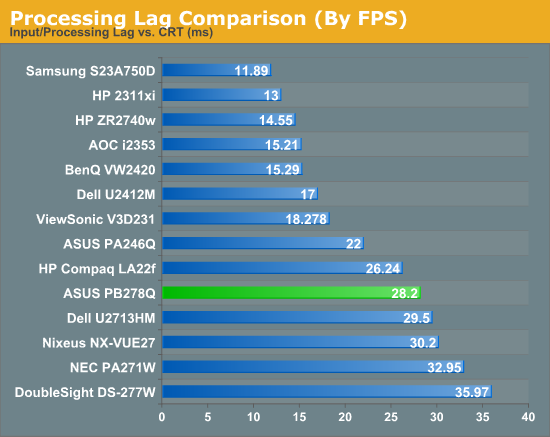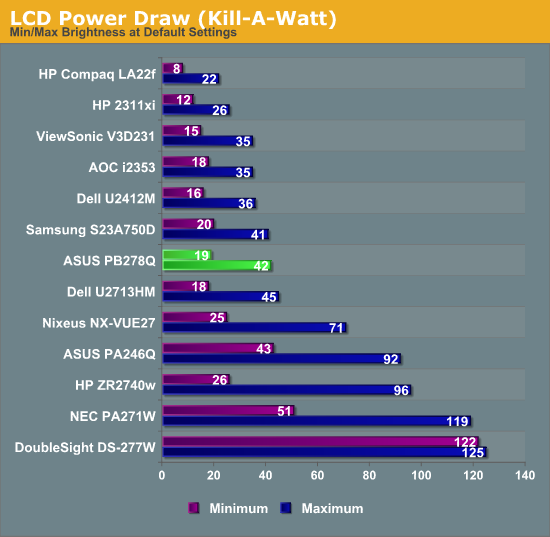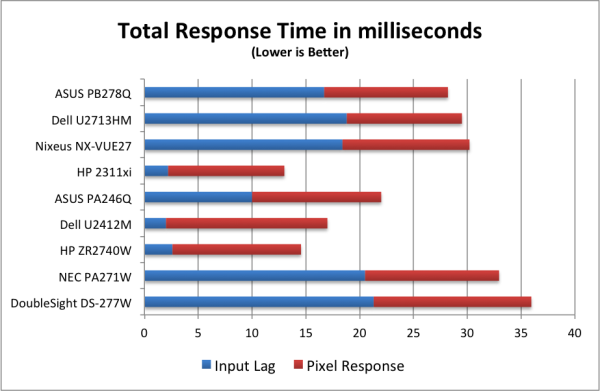ASUS PB278Q Review: An IPS Competitor Emerges
by Chris Heinonen on November 19, 2012 11:00 PM ESTASUS PB278Q Input Lag and Power Use
Unlike the prior 27” displays that we've tested, the ASUS has a 1:1 pixel mapping mode and a full stretch mode for 1920x1080 content. This finally allows me to test and see if the issue with higher lag on 27” displays is being caused by stretching the 1920x1080 signal to fill a 2560x1440 screen, or if it's the inputs and other hardware causing the issue. The lag numbers for the PB278Q are right about what we’ve been seeing for 27” displays, with 16.7 ms of input lag and 11.5 ms of response time for the pixels. This gives us a total overall delay of 28.2 ms using the DVI input. Switching from Full to 1:1 gives no change in the results at all.
Because of this, it seems that the lag in the 27” displays isn’t caused by running at non-native resolution, at least in this case, but more likely by the electronics that deal with display settings and input switching. So even if you run the ASUS at 2560x1440 instead of 1920x1080, I would guess you will see the same results for lag, which is around 1.5 frames in real-world use.

I also did some testing of the TraceFree options using the PixPerAn program to see how that impacts motion blur. The default setting is 60 (and why a control goes from 0-100 but only allows 6 settings is a whole different discussion) and that provided the best results to my eyes. Settings below that lead to more blurring of the pixels behind the car, and settings above that lead to artifacts around the car. TraceFree offers no change to the lag timing but does provide an improvement for motion blurring.
Power use on the ASUS is almost as good as I have seen on a 27” display to this point. With a full white screen it is a little lower than the Dell U2713HM, and with a black screen it is only 1 watt more. Of course the Dell has a higher level of light output than the ASUS does, so if I were to test it at 300 nits it would likely use even less power than the ASUS does for the same level of light output. This is probably only a difference of 1-2 watts at the most, so they really use the same amount of power.

Even if the Dell is the same for power use, the ASUS still uses very little power relative to almost any other 27” display out there, and it will do a good job of keeping your power draw low.











55 Comments
View All Comments
praeses - Monday, November 19, 2012 - link
Can you get the PWM frequency used for the backlight? If its variable, then at 25%, 50%, and 75% brightness levels?DaFox - Tuesday, November 20, 2012 - link
PWM frequency is very important to me as well these days.martyrant - Tuesday, November 20, 2012 - link
+1WoodyPWX - Wednesday, November 21, 2012 - link
That's why I bought the Dell U2713HM. It doesn't use PWM at all => no visible flickering. My eyes are very sensitive to that.p05esto - Tuesday, November 20, 2012 - link
I would like some opinions on does PWM matter? I sit in front of a screen ALL day and most nights. Does PWM matter to my eyes and ability to stay focused? I think my currentl monitor uses PWM (I tried the camera test, just roughly but I saw lines).Death666Angel - Tuesday, November 20, 2012 - link
Huh? Only you can answer that question. If you don't have trouble with a monitor with a PWM back lighting, then it obviously doesn't matter to you. Great article about it: http://www.prad.de/en/monitore/specials/backlight.... And they test PWM frequency with every monitor they get nowadays. :)gevorg - Tuesday, November 20, 2012 - link
Checkout this article on how to measure PWM of your monitor:http://www.tftcentral.co.uk/articles/pulse_width_m...
demonbug - Wednesday, November 21, 2012 - link
Interesting. Discovered mine is at 240 Hz, which would explain why I get that flickering feeling (it's a cheap TN panel with an LED backlight, so not surprising). I'll have to try running it at higher brightness and see if that helps.Oxford Guy - Tuesday, November 20, 2012 - link
Eyestrain isn't always easy to detect.The bottom line is that there are PWM-free panels now and they simply don't flicker.
A cheap way to stop PWM flicker is to turn a PWM monitor to full brightness. A TN panel can be tilted vertically to make the brightness more bearable. But, it's better, of course, to get a constant control backlight.
jjj - Monday, November 19, 2012 - link
not bad not great so it comes down to price and that's not all that attractive.You should see if you can get your hands on that extra wide 29 inch Dell,they started selling it at 699$ (it can be had for 630 with a code atm).